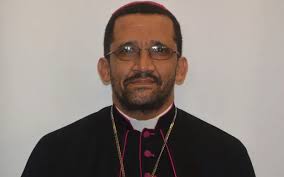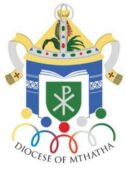SEPTEMBER BISHOP'S COMMUNICATION

Reflection on two key themes for August and September
As we launch our Pastoral plan this month, I wish to revisit its second theme, “Established in our Faith,” by reflecting on two themes, namely the Eucharist and creation.
The Eucharist suggests itself for reflection for two reasons: In August, we took a three-week pause from the Gospel of Mark, which we are reading during this liturgical year, and instead, read chapter 6 of John’s
Gospel, which talks about Jesus as the bread of life.
Furthermore, the pastoral plan we are launching this month with its theme “Abide in me” identifies the Eucharist as a means of abiding in Christ. Therefore, this justifies a pause to reflect on the Eucharist.
The Church has set September aside for reflection on caring for creation, hence the consideration of reflection on creation in this newsletter. As we will see, the Eucharist is relevant to creation, and so part of this reflection will include relating the Eucharist (which we regularly celebrate) to creation.
I am making these efforts to explain what we believe so that when our pastoral plan says we must be “established in our faith,” we do not think so much about memorising the articles of our faith but
understanding what we believe. Peter advises that we must “always be prepared to make a (logical) defence to anyone who asks you for a reason for the hope that is in you” (1Pt.3:15). So here we go!
What does it mean to eat and drink the body and blood of Christ?
Central to what we believe about the Eucharist is that when we receive communion, we eat and drink Christ’s actual body and blood. We take this for granted today because we think we understand it, but do we?
Those who first heard about this (see the Gospel read two weeks ago) found it “a hard saying…and many disciples turned back and no longer walked with him” (Jn 6:60,66).
When you think about it, it has the meaning of cannibalism. In fact, in the early centuries of Christianity, Christians were accused of being cannibals precisely because of this belief that they were eating the body
of Christ and drinking his blood. So, apart from being stubborn literalists about this teaching, how do we meaningfully talk about it?
Feminine metaphors help to express belief about the Eucharist.
My newsletter last month, Women’s Month, highlighted the need to use as many categories and metaphors as possible to talk about God and the mysteries of the faith. Human language, precisely because it is human, can never say enough about God and the mysteries of the faith because if it did, God would not be God, and mysteries would not be mysteries. We need as many expressions and metaphors as possible
to understand the mysteries of faith better, including feminine metaphors.
Sr. Barbara Reid particularly finds the image of a woman helpful in explaining what it means to eat and drink Christ’s body and blood when she states:
Just as a mother gives her flesh and blood to nurture a new life carried within her and then continues to feed the child from her own body after it is born, so Jesus nourishes with his very self all who are birthed to new life through him (John3:3.
Similar to the union of mother and child, while the latter dwells in the womb, so Jesus promises, “Those who eat my flesh and drink my blood abide in me and I in them” (John 6:56). Our response to the One who gives his flesh and blood for our life and that of the world is not only intellectual assent. Jesus gives his flesh and blood an expression that connotes the whole person. So, we entrust our whole selves to him, body, mind,
and spirit, expressed in our physical partaking of the Eucharistic body and Blood. There is no adequate answer on an intellectual level to the question, “How can this man give us his flesh to eat?” rather than trying to explain the “how,” he invites us into the depths of the “who.” (in GIVE US THIS DAY August 2024:199)
While this image of a woman is helpful, it does not explain everything there is to know about eating and drinking Christ’s body and blood; it only throws some light. More metaphors are still needed because we are
dealing with a mystery here.
The metaphor of the planet as Home helps to take care of it
If the image of a woman helps us to understand the baffling teaching of Christ giving us his body and blood to eat and drink, Pope Francis, in his encyclical Laudato Si (LS), appeals to the image of a home as
something that could help us to love and take care of the planet earth.
In normal circumstances, one cares for one’s home and keeps it clean. It is only those who are drug addicted who are always in a daze, and when they wake up, they look for what they can destroy or steal to sell from home and buy drugs. Similarly, those who destroy the earth are those who are addicted to its material elements and care only about feeding their addiction to materialism with no concern about the damage they cause to the planet.
For this reason, Pope Francis calls humanity to “ecological conversion”, which he hopes will make people
stop seeing the planet as something to be exploited but as a home to be taken care of.
The point of ecological conversion is that it requires living a lifestyle that enhances the environment’s well-being every day, from morning to evening. The Pope offers practical suggestions to this end, which
include: “avoiding the use of plastic and paper, reducing water consumption, separating refuse, cooking only what can reasonably be consumed, showing care for other living beings, using public transport
or car-pooling, planting trees, turning off unnecessary lights, or any number of other practices” (LS 211). He exhorts us not to “think that these efforts are too small to improve our world’ (LS 212).
Viewing elements of nature as “our brothers and sisters.”
Another image the Pope uses when referring to the relationship between the earth and humans is a sibling relationship; we are family with the planet.
About our family relationship with creation, Pope Francis reminds us that all elements of creation are bonded by love when he says:
“Everything is related, and we human beings are united as brothers and sisters on a wonderful pilgrimage, woven together by the love God has for each of his creatures and which also unites us in fond affection with
brother sun, sister moon, brother river and mother earth” (LS92).
He thus reminds us that the earth, our common home, “is like a sister with whom we share our life and a beautiful mother who opens her arms to embrace us” (LS1). He tells us that “our very bodies are made
up of her elements; we breathe her air, and we receive life and refreshment from her waters.” (LS2).
In using this language of genetic affinity between us and creation, the Pope hopes to induce sentiments of care toward it in us. The injunction of Gen 2:15 to human beings regarding creation must be understood in
its entirety: ” Till it” but also “take care of it” because the planet is your
sibling.
Eucharist as motivation to take care of creation
In the Catholic Church, we celebrate Mass regularly, and if we pay close attention to it, we will realise its ecological implications. At the offertory, the priest lifts up the bread and wine for consecration
and says.
“Blessed are you, Lord God of all creation, for through your
goodness we have received the bread we offer you: fruit of the
earth and work of human hands, it will become for us the
bread of life.” Likewise, for wine, he says: “Blessed are you,
Lord God of all creation, for through your goodness we have
received the wine we offer you: fruit of the vine and work of
human hands, it will become our spiritual drink.
Let us realise that in this prayer, all the factors that contributed to us having the bread and wine to offer, “the tiniest bacteria, insects, earthworms, etc., are included in the process, whereas the various factors that contributed to the advent of life are brought together again to cooperate. Also present in this cooperation are heat and solar radiation, water, air, cosmic and terrestrial energies.” (Rhabi 2016:173).
Without these elements having cooperated, there would be no bread and wine to offer, so in this prayer of offering, we appreciate all aspects of nature and commit to caring for them. Furthermore, in Eucharistic
Prayer IV, just before praying over the gifts to be the body and blood of Christ, we say, “United with them (Angels) and in the name of every creature under heaven, we too praise your glory as we say: “Holy, Holy,
Holy.”
Celebrating the Eucharist, therefore, while not showing care for creation, to say nothing about actively destroying it, is a contradiction that requires conversion. Let us use this month of September to heighten our awareness about the care for creation and, more importantly, to behave in a creation-friendly manner.
May God Bless you.
+Sithembele Sipuka
Bishop of Mthatha
